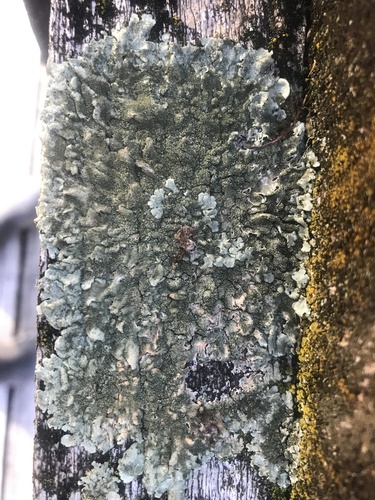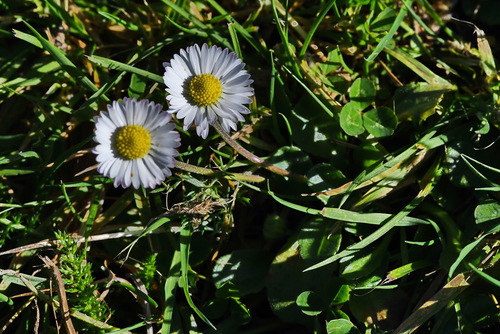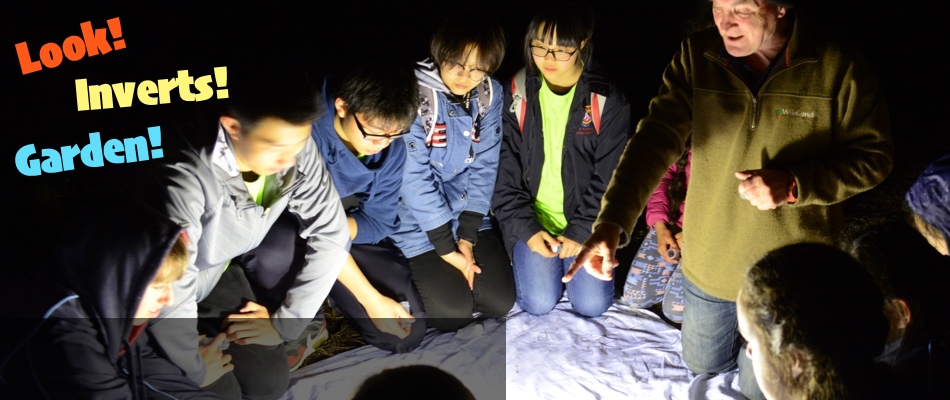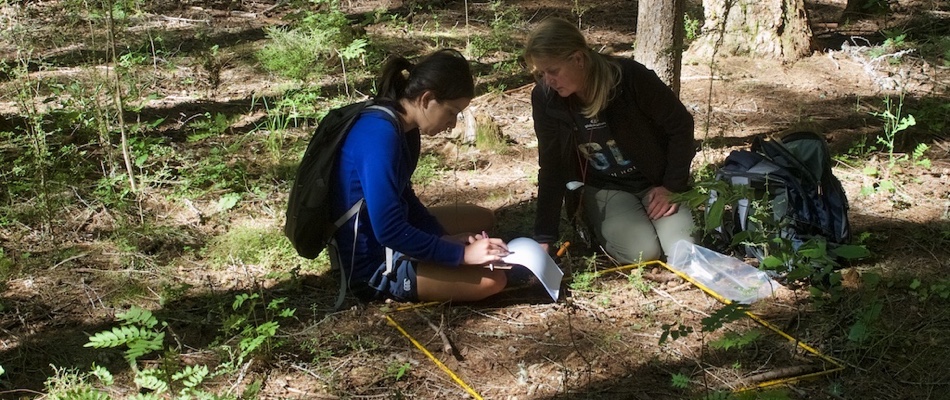StayiNatHome: 20 minute weekend challenges in your garden
Now that you've got the hang of iNaturalist and got started with the City Nature Challenge weekend, what's next? To better explore your garden over this City Nature Challenge weekend, here are some prompts to get you outside exploring. Let's call them challenges. None should take you more than 20 minutes.
By doing one or more of these six 20 minute challenges, you'll be contributing a more detailed snapshot of one aspect of nature in your garden.
Take your pick of the options. Pick as many as you like. Can you do them all?
For each one you do, add the right hashtag to your observations' notes so we can pull all of these observations together at the end.
What's flowering and fruiting
Hashtag #fruitflowers
Have a hunt through your garden for any plants in flower or fruit. Photograph any that you find. Some flowers and fruit are quite small so look carefully.
On the iNat NZ website, people will annotate your photos with your plants' "phenology" (flowering, fruiting, flower budding).
If you don't find anything in fruit or flower, just take a photo of any plant in your garden and add the hashtag #20minfruitflowers to that so we know that you looked.
Why? Flowering and fruiting times of plants are often driven by the climate and the climate is changing. Animal species, like many insects and birds, rely on these flowers and fruit for food. The key step for understanding how flowering and fruiting times are changing is getting lots of observations of when plants are reproductive.
More? The NZ Plant Phenology project on iNaturalist NZ is accumulating observations of which plants are fruit and flowering when and where across New Zealand. If you join the NZ Plant Phenology project and add your observations there, you will be asked to fill in a few more details about your plants that make your observations even more useful.
20-minute bird count
Hashtag #20minbirds
Take 20 minutes in your garden to see how many bird species you can see and hear from your garden. For your first observation, please also type in the time you started your survey (eg #20minbirds start:1:10 pm).
The bird experts on iNaturalist NZ will be quick to ID any bird you can photograph or record singing. If you're new to bird ID, the good folks over at the garden bird count have a handy guide to common garden birds.
To keep things simple, we're just wanting to know which bird species you can see or hear in 20 minutes in your garden, not how many individual birds there are of each species.
(If you like, you can mention your counts of each species in your notes on the iNaturalist app, or if you're on the iNaturalist NZ website, you can add our "Count" observation field to your observations.)
Why? New Zealand under lockdown is a strange, unplanned experiment for our urban birds. How are they reacting to the lack of cars and cafes and noise? Your garden bird counts can help us find out.
More? If you're keen on birds, note that the New Zealand Bird Atlas project is running throughout New Zealand.
Garden Invertebrate Hunt
Hashtag #gardeninverts
The Garden Invertebrate Hunt project on iNaturalist has eight simple methods you can try to survey invertebrates in our gardens. These are described, with instructional videos, in this Garden Invertebrate Hunt article.
The eight Garden Invertebrate Hunt methods are as follows. They're all simple and designed to be easy to do from home without any special equipment: visual search, searching plants for damage, beating big plants, flower visitors, under things on ground, at night light, pitfall trap, and pan trap. You can find instructions of each of these here.
Why? It's the little things that run the world's ecosystems, but they're so often overlooked as we focus on the more obvious bird versus mammal story in NZ. There's growing concern around the world about the health of our invertebrates, especially pollinators. By surveying the invertebrates in your garden, you contribute to a dataset that researchers can use to uncover trends. Invertebrates are also still the wild west of discovery and there's a good chance that you'll find a species that's never been recorded in your neighbourhood before.
More? If you're keen, you can join the Garden Invertebrate Hunt project and add your observations to that project.
Lichens
Hashtag #gardenlichens
Lichens are these amazing, tight mutualisms between species from 2–3 kingdoms of life. They're a house built by fungus containing algae and sometimes cyanobacteria. The species work together to become one hardy, successful life form.
How many different lichens can you find in your garden? What are each growing on? Look on rocks, tree trunks, walls, and other old structures.
You can check out all of the 637 lichen species found so far on iNaturalist NZ here.
Why? Lichens are cool, but largely overlooked. We know very little about which lichens are growing where in NZ's towns and cities. Your observations will be a big help.
More? The Lichens of NZ project on iNaturalist NZ is the go-to place to meet New Zealand's lichen enthuiasts.

@martinsnz found this native lichen growing on a wooden fence rail in Auckland earlier today, which has been identified as Xanthoparmelia murina by up-and-coming NZ lichen expert @marleyii.
Wild seedlings
Hashtag #gardenseedlings
What wild woody plants are regenerating in your garden? Look for and photograph seedlings of wild woody plants (anything < 50 cm tall). The plant experts on iNat NZ will do their best to identify every seedling you find.
It's also interesting to know whether the parents of each seedling are in your garden. Have a look around for the nearest adult plant of the same species, and photograph that too if you find it.
Why? As our towns and cities get older and woodier, there's more natural regeneration happening. It's great to know about this because it tells us both which native trees and shrubs are naturally regenerating in our neighbourhoods, and also gives us an early warning sign for what the new woody weeds of the future might be.
More? The Woody Seedlings in a Square Metre project gathers together a standardised dataset of which woody seedlings, and how many, are found in random square metres placed in habitats throughout New Zealand. If you'd like to contribute, measure out one square metre in your garden, in a habitat suitable for woody seedlings, and add your observations to the Woody Seedlings in a Square Metre project.
Lawn plants
Hashtag #lawnplants
If you get down on your hands and knees, you'll find that a garden lawn is much more than just grass. There can be 50 plants species all growing together in an old garden lawn. How many species can you find? Photograph each different plant species you can find in your lawn.
Let's see who has the most diverse lawn in NZ!
Why? Lawns are a microcosm of plant ecology, like a rainforest in miniature down at your feet. Different species are competing for dominance and which lawn species dominate where under what conditions is giving plant ecologists insights into how all plant communities function.

@david_lyttle photographed this common daisy yesterday in a lawn in Dunedin. This species is often found growing in NZ lawns.
A word about habitats
There's a surprising diversity of habitats to be found in a typical home garden, especially from the perspective of something small like an insect or lichen or seedling. Think about where in your garden you're finding different species, and why those habitats are the best places for those species.
One way to work through your garden looking for species is to focus on one type of habitat at a time. Here's a helpful list of common garden habtiats from @meurkc that you might like to use to structure your exploring.
- Parkland/Woodland (open forest, scattered trees > 3m tall)
- Orchards
- Shrubbery (scattered shrubs up to 3 m tall)
- Herbaceous Border/flower bed (large flowering herbs, tussocks, NZ flaxes)
- Vegetable Garden
- Rock gardens and green roofs
- Walls/fences (brick, rock, stone, concrete, wood, letter boxes)
- Lawns/meadows
- Paths/drives/gutters (cracks and edges)
- Wetlands/Streams (seepages, creeks, rivers, drains, floodplains, ponds)
- Inside the house (pot plants, spiders and moths)
You can add in the notes of your observations which habitat a species was found in.
Happy exploring!

Do also keep looking out for fungi in your gardens. Yesterday, @geoffr photographed this spectacular Ganddalf's flycap mushroom in a garden in Wellington.








Comments
Add a Comment